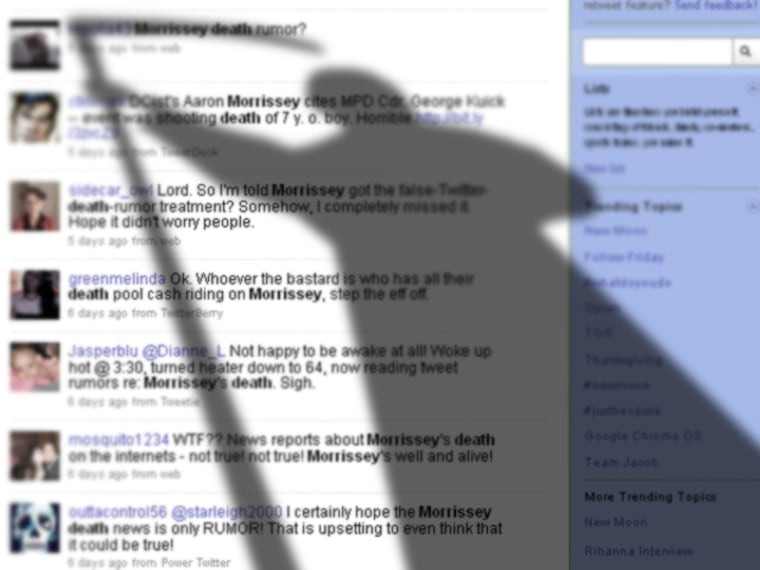Earlier this week, the New American Oxford Dictionary announced the addition of social network slang “unfriend” to its next edition, vexing armchair vocabulists everywhere. And yet “gullible” is still not in the dictionary!
Seriously, it’s not. Go look! We’ll wait ... Doot de doot de doo ...
Ok. That was, like, middle-school lame. Apologies. My game has been off ever since I learned Morrissey, of Smiths and solo-career fame, is maybe dead, someone heard or something that I read via Twitter, the very same medium possibly hosting a serial killer! Other media outlets gave credence to the info received from the microblogging service. So who’s gullible now?
Everyone, apparently. This includes The New York Times’ The Moment blog and its Twitter feed, which made the rookie mistake of not thinking before tweeting regarding the unhappy (and untrue) Morrissey rumor run rampant. Let’s not even get started on a post on TechCrunch’s European blog that gave a bit too much credence to what is at worst a lame viral campaign and/or attempt to get a book deal posing as a jejune serial killer on Twitter.
None of these items are likely true (at least at the time of this posting). OK, somebody calling themselves @dinner_guest is posting tweets cribbed from Dr. Michael Stone's Scale of Evil, totally ripping off my “Law & Order” spec script and getting way more followers than the banal bon mots deserved. But whatever.
That doesn’t stop the socially networked masses from spreading such screaming unlikelihoods at roughly the speed of light. But contrary to those who blame the Internet for, well, everything — but in this case, our willingness to believe pretty much anything — this isn’t new. It’s just faster. You know, like them new-fangled horseless carriages. And with added speed, comes danger.
According to a post on the Museum of Hoaxes Web site, “the great death rumor craze of 2009” is a “textbook case of how rumors spread.” Following a rapid succession of celebrity deaths, including Michael Jackson’s shocking demise, Twitter was ripe with celebrity death rumors that the masses swallowed like Flintstones vitamins.
As media gossip blog Gawker points out in its post busting The New York Times Moment tweet for its Morrissey assumption, it takes certain finesse to successfully execute the viral spread of false information. One trick is to spread info about someone just obscure enough and/or out of the main spotlight so that his or her death would not cause a break in regular programming.
This method was so used and abused over the “great death rumor craze of 2009,” it’s no wonder we all found it a little hard to believe pitchman Billy Mays, and more recently Ken Ober (host of MTV’s ’80s game show “Remote Control”), were really, truly gone.
Before that, Zach Braff was forced to calm the shattered masses via a YouTube video when rumors of the “Scrubs” star’s tragic fall from a peak in New Zealand or something reached critical Twitter mass. Jeff Goldblum said he fielded calls from concerned friends and family when the same medium spread the same rumor of his alleged death — later “confirmed” by an Australian newspaper. That Hannah Montana chick also suffered that same false fate, back when Twitter rumors were knocking off celebrities like Disney nature documentarians herding lemmings off a cliff.
Indeed, multiple media outlets, including The New York Times, ran trend pieces about the morbid meme. But much to the Museum of Hoaxes’ irritation, “journalists are focusing on the rumors as an Internet phenomenon.” Seriously. It’s like they never heard about that kid Mikey from the Life cereal commercials who put Pop Rocks in his Coca-Cola ... and died! It’s true! Go check Wikipedia ... we’ll wait.
Doot de doot de doo ...
Speaking of Wikipedia — your No. 1 source for late-breaking inaccuracies — remember President Barack Obama’s inauguration day last year? The speed with which some rabbit-reflexed webmaster changed regimes on the White House Web site couldn’t match the mad skillz of the jackass responsible for breaking the big fake news on Wikipedia that Sen. Ted Kennedy had died following his health-related departure from the day’s festivities.
That’s the same free, open source Web site where U.S. blogs and newspaper Web sites in Britain, Australia and India cut and pasted an obituary-friendly (but false) quote from the Wikipedia entry of deceased composer Maurice Jarre, placed by a student just hours after the French composer's death.
Wikipedia is also the site that briefly stated that David Beckham was a Chinese goalkeeper in the 18th century, Tony Blair worships Hitler and Conan O'Brien assaults sea turtles while canoeing, among other erroneous fun facts that puckish jackasses posted, and the gullible masses believed … because why?
Because humans are weird, complicated organisms always looking for a break in the day.
Again, while this all happens on the Internet, let’s not blame the latest messenger. “Before the Internet people found many other ‘decentralized’ ways of spreading rumors: fax, telephone, college radio stations, letters, corner drugstores, or word of mouth,” the Museum of Hoaxes reminds. “And while the Internet does allow information to spread faster, from more sources, it also allows misinformation to be debunked faster.”
Which is why I’m using Google news alerts even as we speak to find the latest on dead Paul McCartney’s evil doppelganger, and when his next record drops.
Follow Helen A.S. Popkin on and/or friend her on where her banal bon mots are at worst a lame viral campaign and/or attempt to get a book deal.
